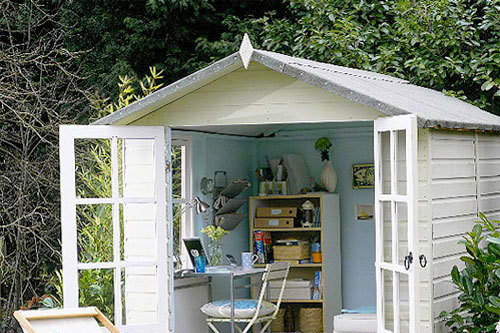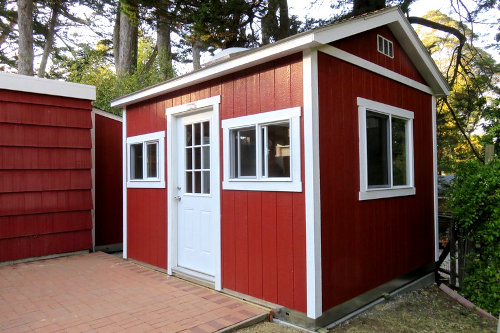Home studio sheds or office sheds are becoming increasingly popular with the working population, and it is not entirely difficult to imagine why. They provide a safe space where people can focus completely on their work without looking over their shoulders. The serene and flexible working environment they provide can also lead to increased productivity.

photo credit: Ebabeyvt / Flickr
These are just a few of the many reasons why workers across all sectors are embracing the trend. If you’re one of those aiming to join the home office train, this article can show you how to go about it. We’ve penned down some of the techniques and steps you can take to build your office shed, starting with the first one below.
Prepare The Grounds
Your first move would be to pick the spot where you’ll like to build the shed. If it is bushy, clear it and then squarely level it. Next, gather all the tools, materials, and supplies you’ll need to build the shed and place them close to the site.
Proceed to contact the local building authorities to get the necessary permits, and then call for the service of a local builder if you cannot do it yourself. But if you have a degree of experience building sheds, you can read through the following steps that are discussed here.
Foundation
You probably have a plan for the office shed, so you can transfer all its physical measurements on paper to the ground. Drive wooden pegs to the ground to mark the corners of the shed and join them together to trace the outline of the walls.
Repeat this step for any extra rooms and lay concrete blocks or any other type of wall along with the marked/traced areas.
Floor
Once you’re done with the foundation, proceed to place the floor. If you opt for a concrete floor, you’ll need to first set up the formwork around the floor’s perimeter using wood or solid profile boards that are cut to the required size of the floor. You may go for wooden floors, where you’ll have to fasten the floor to the foundation under it.
Whichever option you side with, make proper provision for heating vents, piping, or any other utilities that’ll have to pass through the floor.
Walls
As soon as the floor is set up, your walls should follow suit. Using the plan and a measuring tape, map out their outline on the floor and leave out the portions that serve as openings for doors. If you have prefabricated walls, you may join them together using the. connections(inter-module). But if you’re building from scratch, you can go on to erect your wall of choice.
If you plan to combine steel framed/stud walls with drywall and insulation boards, ensure that the frames have sufficient space to fit them in. Make sure your walls are plumb and flush across all sides.
Windows and Doors
If you have opted for a prefabricated wall of windows, you may sit this one out. But if this is not the case, you would have left out openings for the windows and doors while setting up the walls.
Your windows should be large enough to allow natural light and air inflow. And your doors should be wide enough to allow the passage of all your office furniture.
Roofing
Your roofing should be simple but adequate, whether you choose a wooden roof, aluminium roof, or any other type of roofing material. If you apply felting to the roof, ensure that the material bonds well to the roof. And if you go for a high-pitched roof, check for the proper alignment of all the rafters and the joists. Your ceiling should be clad with an insulation layer, and if you opt for roof shingles or modular roofs, ensure that they slot properly into their grids.
Now that you’re done with the framework of your home office shed, you may go on to equip it with all the necessary utilities, starting from electricity.

Electricity
You may contact the relevant authorities to request electricity, and they should give you the green light to connect with the nearest power source. If your house is very close to the shed, get an electrician to draw power from the place. Next, assemble sockets, switches, fittings, and other electricity supply fixtures and allocate them to choose spots around the shed.
Heating and Insulation
If you’ve previously made provisions for heating through the siting of vents and thermal breaks around the floor or walls of your shed homes, you are good to go. But if this is not the case for you, you can still install free-standing heating tubes or mount them on the walls.
The same goes for insulation, except that you can only add an insulation fabric to the walls. You may go for fiberboards, clad the walls with other synthetic insulation materials and fill up all the cavities inside the walls.
Lighting
Your lights play a crucial role in your home office and can help you exert maximum focus on your job. You may make use of LED lights to get the best results or fluorescent lights to get something similar.
Let the lights beam across your work area or get desk lamps to get closer to the scene of action. To make it even better, go for lamps that have provisions for varying the intensity and the colour temperature.
Finishing
Your finishing should typically begin with a thorough paint job on the walls and proceed to any additional flooring provision. You may top off your floor with a laminate spread or layout tiles across its entirety. And then you can personalize the space and add a few touches in vantage points across the place.
Throw in window blinds and fix a couple of wall frames to hold your favourite pictures. Create extra storage space on the walls using pegboard, racks, brackets, and a wall-mounted adjuster.
Load It Up
This is the point where your home starts to take its intended shape. You may now equip your office shed with all the materials, equipment, and resources you need for your work. Throw in a couple of chairs and desks, a workbench, cabinets, shelves, and lockers.
Proceed to bring in computers, printers, stationeries, and other office supplies.
Provide Security
From glass break sensors at the windows to smart locks at the doors, design the openings in your home office to alert you to any break-in attempts. You can also place a camera at the front to deter intruders and build a small hedge or gate around it.